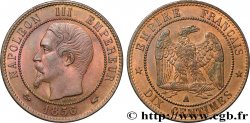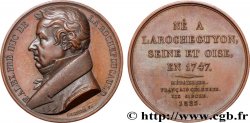上一页 1/1
fme_1028658 - SECOND EMPIRE Médaille, École impériale d’Arts et Métiers
无库存.
所有在网站上销售的产品.
价格 : 250.00 €
所有在网站上销售的产品.
价格 : 250.00 €
种类 Médaille, École impériale d’Arts et Métiers
日期: 1859
铸币厂名称/城市 49 - Angers
材质 silver
直径 41 mm
模子方针 12 h.
硬币制模工 BARRE Albert Désiré (1818-1878)
重量 36,34 g.
侧面 lisse + main ARGENT
印模 main indicatrice (1845-1860) et ARGENT
关于品相的说明
Médaille nettoyée, présentant des coups et rayures, notamment sur la tranche
出版目录中的项代码 :
家谱
Collection JCT
正面
正面的文字 NAPOLEON III - EMPEREUR.
正面的说明书 Tête nue de profil à gauche ; signé : BARRE.
背面
背面的文字 ÉCOLE IMPÉRIALE D’ARTS ET MÉTIERS - (ANGERS) // RÉCOMPENSE / A / DAUZATS / GUILLAUME / 1859.
背面的说明书 Légende circulaire et en 4 lignes dans une couronne de chêne.
评论
Cette médaille a été décernée à Guillaume-Vincent Dauzats (Angers 1856) (1842-1884). Dès sa sortie d’école, ce dernier entre aux usines du Creusot puis rejoint en 1861 l’entreprise Peteau, constructeur à Passy en tant que chef des études. Il sera ensuite chef du service travaux en 1873 à la Compagnie du Canal de Suez, puis ingénieur conseil dans la Compagnie du canal de Corinthe.
This medal was awarded to Guillaume-Vincent Dauzats (Angers 1856) (1842-1884). Upon leaving school, he joined the Creusot factories and then in 1861 joined the Peteau company, a construction company in Passy, as head of studies. He then became head of the works department in 1873 at the Suez Canal Company, then consulting engineer at the Corinth Canal Company.
This medal was awarded to Guillaume-Vincent Dauzats (Angers 1856) (1842-1884). Upon leaving school, he joined the Creusot factories and then in 1861 joined the Peteau company, a construction company in Passy, as head of studies. He then became head of the works department in 1873 at the Suez Canal Company, then consulting engineer at the Corinth Canal Company.








 对产品描述纠错
对产品描述纠错 打印
打印 分享我的选择
分享我的选择 提问
提问 Consign / sell
Consign / sell
 产品介绍
产品介绍















